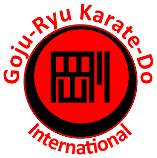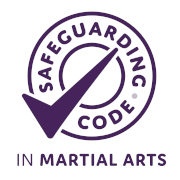Karateka Login
- Gary Brandon
(Birmingham Welfare Officer)
gb@carisbrookeboston.com
Mobile: (07956) 510-093 - Matthew Taylor
(GKI Welfare Officer)
matt.sensei@twyfordkarate.club
Tel: (0118) 9706-943
Mobile: (07766) 684-254 - Carly Barrett-Greening
(GKI Supporting Contact)
waveconnections@outlook.com
Mobile: (07850) 732-303
News
-
The GKI Winter Gasshuku 2024Monday, 11th November, 2024The GKI Winter Gasshuku was hosted in Birmingham and was very well attended with over 100 students from Portugal, Spain, Belgium, Sweden and the UK. Sensei James Rousseau, Sensei
-
The GKI Winter Gasshuku 2022Saturday, 26th November, 2022The GKI's winter gasshuku was held last weekend and it was very well attended not only by the UK contingent but also Portugal and Sweden put in a good showing too. Both Tristan
History
The development of Goju-Ryu goes back to Higaonna Kanryo, (1853 - 1916), a native of Naha, Okinawa. Higaonna began studying Shuri-te as a child. He was first exposed to martial arts in 1867 when he began training in Luohan or "Arhat boxing" under Arakaki Seisho, a fluent Chinese speaker and translator for the court of the Ryukyu Kingdom.
In 1870, Arakaki went to Beijing to translate for Ryukyuan officials. It was then that he recommended Higaonna to Kojo Taitei, under whom Higaonna began training.
With the help of Taitei and a family friend, Higaonna eventually managed to set up safe passage to China, lodging, and martial arts instruction. In 1873 he left for Fuzhou in Fujian, China, where he began studying Chinese martial arts under various teachers.
 Higaonna Kanryo, circa early 1900s
Higaonna Kanryo, circa early 1900sIn 1877 he began to study under Ryu Ryu Ko. Tokashiki Iken has identified him as Xie Zhongxiang, founder of Whooping Crane Kung Fu. Zhongxiang taught several Okinawan students who went on to become karate legends.
Higaonna returned to Okinawa in 1882 and continued in the family business of selling firewood, while teaching a new school of martial arts, distinguished by its integration of go-no (hard) and ju-no (soft) kenpo into one system. Higaonna's style was known as Naha-te. Goju-kai history considers that Chinese Nanpa Shorin-ken was the strain of kung fu that influenced this style.
Higaonna Morio noted that in 1905, Higaonna Kanryo taught martial arts in two different ways, according to the type of student: At home, he taught Naha-te as a martial art whose ultimate goal was to be able to kill the opponent; however, at Naha Commercial High School, he taught karate as a form of physical, intellectual and moral education
Higaonna's most prominent student was Chojun Miyagi (1888 - 1953), the son of a wealthy shop owner in Naha, who began training under Higaonna at the age of 14. Miyagi had begun his martial arts training under Arakaki at age 11, and it was through Arakaki that he was introduced to Higaonna. Miyagi trained under Higaonna for 15 years until Higaonna's death in 1916.
In 1915 Miyagi and a friend Gokenki went to Fuzhou in search of Higaonna's teacher. They stayed for a year and studied under several masters but the old school was gone due to the Boxer Rebellion. Shortly after their return, Higaonna died. Many of Higaonna's students continued to train with Miyagi and he introduced a kata called Tensho which he had adapted from Rokkishu of Fujian White Crane.
Higaonna's most senior student Juhatsu Kyoda formed a school he called Toon-ryu (Toon is another way of pronouncing the Chinese characters of Higaonna's name, so Toon-ryu means "Higaonna's style"), preserving more of Higaonna's approach to Naha-te.
In 1929 delegates from around Japan were meeting in Kyoto for the All Japan Martial Arts Demonstration. Miyagi was unable to attend, and so he in turn asked his top student Jin'an Shinsato to go. While Shinsato was there, one of the other demonstrators asked him the name of the martial art he practiced. At this time, Miyagi had not yet named his style. Not wanting to be embarrassed, Shinsato improvised the name hanko-ryu ("half-hard style"). On his return to Okinawa Prefecture, he reported this incident to Chojun Miyagi, who decided on the name Goju-ryu ("hard soft style") as a name for his style. Chojun Miyagi took the name from a line of the poem Hakku Kenpo, which roughly means: "The eight laws of the fist," and describes the eight precepts of the martial arts. This poem was part of the Bubishi and reads, Ho wa Goju wa Donto su "the way of inhaling and exhaling is hardness and softness," or "everything in the universe inhales soft and exhales hard."
In March 1934, Miyagi wrote Karate-do Gaisetsu ("Outline of Karate-do (Chinese Hand Way)"), to introduce karate-do and to provide a general explanation of its history, philosophy, and application. This handwritten monograph is one of the few written works composed by Miyagi himself.
Miyagi's house was destroyed during World War II. In 1950, several of his students began working to build a house and dojo for him in Naha, which they completed in 1951. In 1952, they came up with the idea of creating an organization to promote the growth of Goju-ryu. This organization was called Goju-ryu Shinkokai ("Association to Promote Goju-ryu"). The founding members were Seko Higa, Keiyo Matanbashi, Jinsei Kamiya, and Genkai Nakaima.
There are two years that define the way Goju-ryu has been considered by the Japanese establishment: the first, 1933, is the year Goju-ryu was officially recognized as a budo in Japan by Dai Nippon Butoku Kai, in other words, it was recognized as a modern martial art, or gendai budo. The second year, 1998, is the year the Dai Nippon Butoku kai recognized Goju-ryu Karate-do as an ancient form of martial art (koryu) and as a bujutsu. This recognition as a koryu bujutsu shows a change in how Japanese society sees the relationships between Japan, Okinawa and China. Until 1998, only martial arts practiced in mainland Japan by samurai had been accepted as koryu bujutsu.


